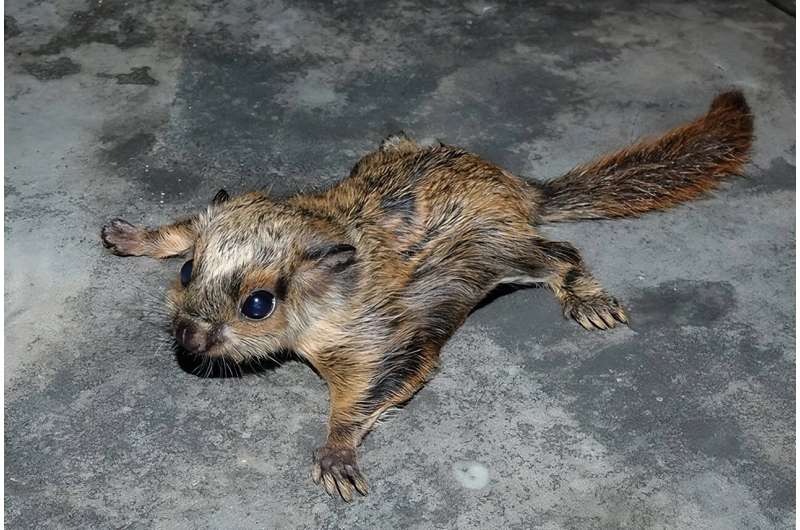This article has been reviewed according to Science X's editorial process and policies. Editors have highlighted the following attributes while ensuring the content's credibility:
fact-checked
peer-reviewed publication
trusted source
proofread
Tropical flying squirrels found to deploy carpentry trick to safely store nuts

Two species of flying squirrel in China's southern rainforests keep their nut stash high and dry by chewing grooves into smooth egg-shaped or rounded nuts and wedging them securely between branches, according to a study published today in eLife.
The behavior demonstrates the animal's cognitive and engineering skills. It also likely contributes to an even dispersal of the nut-producing trees throughout the rainforest.
In temperate regions, squirrels routinely bury nuts or store them in tree hollows or logs for use during lean times. In humid rainforests, however, nuts would rapidly decompose or germinate in the ground or wood cavities. A team of scientists studying the rainforests on Hainan Island, South China, recently stumbled upon a clever alternate storage strategy used by tropical squirrels.
"We inadvertently discovered nuts of two tree species suspended above the ground in y-shaped crotches between branches on understory shrubs and saplings," said co-lead author Han Xu, a Professor at the Research Institute of Tropical Forestry, Chinese Academy of Forestry in Guangzhou, China. "The smooth oblong nuts had unusual grooves and were firmly wedged in place." Xu served as co-lead author of the study, alongside Lian Xia, a postgraduate student at the College of Forestry, Hainan University, Haikou, China.
To find out how the nuts got there, Xu, Xia, and their colleagues used infrared cameras to observe how the nuts were winding up suspended above the ground. They discovered that Indochinese Flying Squirrels and Particolored Flying Squirrels, two species that are active only at night, were the culprits.
The videos revealed the squirrels chewing grooves on the nuts and placing them with the branches firmly wedged in the grooves. The placement creates a very sturdy joint like the mortise-tenon joint that carpenters use to affix legs on furniture.
The squirrels were meticulous about their work. They placed the nuts between small twigs connected at 25–40-degree angles, roughly two meters above the ground, and about 10 to 25 meters from the nearest nut-producing tree.
"Squirrels used repeated bouts of chewing and positioning to achieve a firm fit," said John R.Spence, Professor at Department of Renewable Resources, University of Alberta, Canada. "It demonstrates that this is a carefully thought-out process."
The nut's placement at a distance from other nut-bearing trees and off the ground likely reduces the likelihood other nut-eating animals will discover them. It may also help disperse the seeds far enough from their parent trees to reduce excess competition and spread this valuable food resource throughout the forest.
"The flying squirrels' unique style of nut storage likely reflects an ecological adaptation to guarantee food access during dry periods in the rainforest when food may become scarce," said Suqin Fang, Associate Professor in the State Key Laboratory of Biocontrol, School of Life Sciences, Sun Yat-Sen University, Guangzhou, China. "We suggest that this behavior also helps the trees and the other plants and animals that rely on them, benefitting overall forest ecology."
More information: Han Xu et al, Flying squirrels use a mortise-tenon structure to fix nuts on understory twigs, eLife (2023). DOI: 10.7554/eLife.84967
Journal information: eLife
Provided by eLife


















